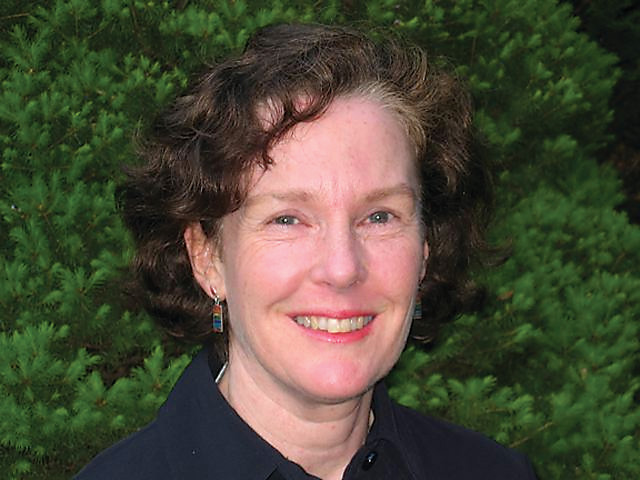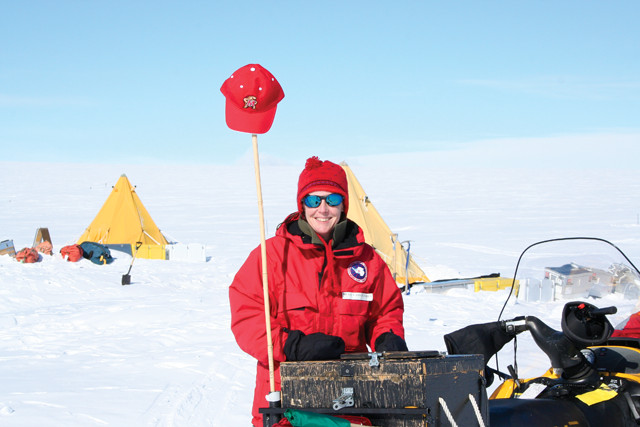
by Zahra Hirji Wednesday, May 23, 2018

Lucy McFadden. Credit: Courtesy of Lucy McFadden
Not many people can say they have an asteroid named after them. But Lucy McFadden, a self-described small planetary objects junkie, can. For nearly 40 years, McFadden has woven her two loves — astronomy and geology — into a career in planetary geology. She has mapped craters on Mercury, participated on NASA missions to comets, and collected meteorites in Antarctica, all in the interest of discovering more about the formation of our solar system.
Asteroids and comets may be the ultimate time travelers, holding secrets to the formation of the solar system billions of years ago, McFadden says. These small planetoids — and their remnants on Earth — may reveal conditions and processes that occurred when the solar system and planets formed. That’s why McFadden’s current mission, NASA’s Dawn project, is en route to orbit and study two very different asteroids. But McFadden’s keen interest in comets and asteroids doesn’t end with the formation of the solar system. She is also interested in what such bodies can tell us about Earth and how these celestial objects can be used to teach kids and get them excited about science.
McFadden is an astronomy professor at the University of Maryland in College Park. Her interest in planetary geology started with an interest in astronomy at Hampshire College in Massachusetts, where McFadden was part of the inaugural class in 1970. “When I arrived as a freshman, everyone was all excited about the new faculty, a new campus and a student body,” she says. “I got into astronomy first.” Her first science class was optical and radio astronomy. “I didn’t know what radio astronomy was,” she says, laughing. In her sophomore year, Hampshire hired a geologist who took students to Arizona and New Mexico for a field trip. “And I thought, ‘Oh this would be really great … I get to see the West.’ It was basically the good marketing and the field trip. I got hooked on geology.” And the rest is history, so they say.
McFadden began to meld the two interests near the end of her undergraduate education. Thanks to Brian O’Leary, a former astronaut and then-principal investigator on the Mercury Messenger Team as well as professor at Hampshire, McFadden and other students spent a semester at NASA’s Jet Propulsion Laboratory at Caltech in Pasadena, Calif.
“I was helping make maps of Mercury,” McFadden says. Under the tutelage of Merton Davies, who was responsible for developing the coordinate systems from which maps of the planets are derived, McFadden became known as the planetary cartographer. “All I did was mark the center of the craters against a grid line printed on the edge of the page,” she says. But her work allowed Davies to develop a grid that located the craters on a three-dimensional shape by referencing the craters to a central crater — “the Greenwich, England, of Mercury,” McFadden says. Furthermore, she says, “I got to participate in all the team meetings where they were discussing the geology and describing the features. It was fun to be there and be introduced to [that] culture of science.”
With a little nudge from a professor, McFadden decided to apply to MIT for graduate school. She arrived in 1976 and started working with Tom McCord, an astronomer who developed a technique for determining the mineral composition of planetary surfaces, such as asteroid surfaces, from reflected sunlight. But a year after McFadden arrived, McCord left MIT for a position at the University of Hawaii and took his entire lab, including McFadden, with him. “It was a great adventure,” she says. With access to the huge 2.2-meter-high Montoka Telescope, McFadden characterized the mineral composition of 17 near-Earth asteroids using McCord’s technique.
But it was not until McFadden was a post-doctoral researcher at the University of Maryland in 1986 that she got her first close-up view of an asteroid. She was chosen to be a science team member of the near-Earth asteroid rendezvous mission, Neroid, where her job was to look for lava flows on the surface of the asteroid Aros. “We found none,” she says. Moreover, she adds, “we found out that some of our observations from the ground were just wrong.”
The Neroid spacecraft only orbited Aros for a year. The mission seemed to start and finish in a blink of an eye, McFadden says. But before she could dwell on the questions left unanswered from Neroid, a new opportunity caught her attention: Deep Impact.
Deep Impact was a mission straight out of a science fiction novel: NASA engineers deliberately crashed a spacecraft into the speeding comet Tempel 1 to determine the comet’s composition, allowing scientists like McFadden a chance “to look beneath the comet’s surface.” The spacecraft was scheduled to hit the comet at 11:30 p.m. Pacific time on July 4, 2005. The entire space team was in a room together watching on a wall of screens, McFadden says, but the team had to wait seven long minutes to see the impact due to the delay in the travel time of light. “Then, all of a sudden, an image came back and it lit up the screen. We could see the impact grow in front of us,” she says. “I was stunned.”

Lucy McFadden camped out in Antarctica for six weeks in search of meteorites. Credit: Lucy McFadden
Besides being a member of the space team, McFadden led Deep Impact’s education and public outreach program, which created lesson plans and led experiments in classrooms related to the mission to inspire kids to take an interest in science. Deep Impact was neat, McFadden says, so it wasn’t very hard to capture the kids’ attention. Now, McFadden is the outreach coordinator for her current mission, Dawn, which launched in September 2007 and is scheduled to go into a nine-month orbit around the asteroid Vesta in August 2011. Then the spacecraft has another three-year journey before reaching its final destination: the dwarf planet Ceres. Vesta and Ceres will be the largest bodies ever visited in the “asteroid belt” between Jupiter and Mars, McFadden says.
To fill her time until 2011, McFadden has found a new way to study asteroids that doesn’t involve a telescope and gets her out of the lab: meteorites. “We know most meteorites come from Vesta,” she says, so studying the meteorites helps build knowledge of the asteroid belt. Nonetheless, she adds, “I am sure we will be very surprised when we get there.”
Collecting meteorites is “a great adventure,” McFadden says. Between 2007 and 2008, McFadden participated in a meteorite search program in Antarctica with geologist Ralph Harvey, head of the Antarctic Search for Meteorites program. McFadden and seven others camped out on the ice for six weeks. “We went to work at 9 a.m. and continued until 5 p.m., driving around on snowmobiles. We found 711 meteorites,” she says. The frequency of meteorite showers is not any higher in Antarctica, but the cold environment makes the preservation and identification of meteorites a lot easier.
There are few small planetary bodies McFadden has not studied. In tribute to McFadden’s contribution to the field, astronomer Edward Bowell, principal investigator of the Lowell Observatory Near-Earth Object Search in Flagstaff, Ariz., named an asteroid — 3066 McFadden — after her. The asteroid is from the main asteroid belt between the planets Mars and Jupiter. It was a real honor, McFadden says. But her contribution to the field is not over; she continues to conduct research and teach. And in 2011, she will finally get a glimpse of some of the largest known asteroids.
© 2008-2021. All rights reserved. Any copying, redistribution or retransmission of any of the contents of this service without the expressed written permission of the American Geosciences Institute is expressly prohibited. Click here for all copyright requests.